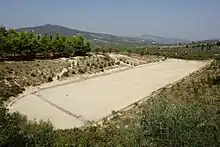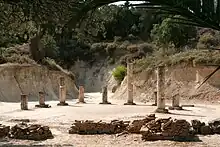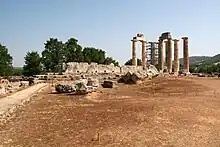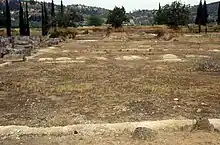Νεμέα (in Greek) | |
 The stadion of Nemea | |
 Shown within Greece | |
| Location | Archaia Nemea, Corinthia, Greece |
|---|---|
| Region | Argolis (ancient Greece) |
| Coordinates | 37°48′32″N 22°42′37″E / 37.80889°N 22.71028°E |
| Type | Settlement |
| History | |
| Events | Battle of Nemea |
Nemea (/ˈniːmiə/; Ancient Greek: Νεμέα; Ionic Greek: Νεμέη) is an ancient site in the northeastern part of the Peloponnese, in Greece. Formerly part of the territory of Cleonae in ancient Argolis, it is today situated in the regional unit of Corinthia. The small village of Archaia Nemea (formerly known as "Iraklion") is immediately southwest of the archaeological site, while the new town of Nemea lies to the west.
Here, in Greek mythology, Heracles overcame the Nemean Lion, and here, during Antiquity, the Nemean Games were held (ending c. 235 BC) and were celebrated in the eleven Nemean odes of Pindar.
Myth, legend and history


In Greek mythology, Nemea was ruled by king Lycurgus and queen Eurydice. Nemea was famous in Greek myth as the home of the Nemean Lion, which was killed by the hero Heracles,[1] and as the place where the infant Opheltes, lying on a bed of parsley, was killed by a serpent while his nurse Hypsipyle fetched water for the Seven against Thebes on their way from Argos to Thebes. The Seven founded the Nemean Games in his memory, according to its aition, or founding myth, accounting for the crown of victory being made of parsley or the wild form of celery and for the black robes of the judges, interpreted as a sign of mourning. The Nemean Games were documented from 573 BC, or earlier, at the sanctuary of Zeus at Nemea.[2]
At the temenos, the grave of Opheltes was surrounded by open-air altars and enclosed within a stone wall.[1] The sanctuary's necessary spring was named Adrasteia: Pausanias wondered whether it had the name because an "Adrastos" had "discovered" it,[1] but Adrasteia, the "inescapable one", was a nurse of the infant Zeus in Crete. The tumulus nearby was credited as the burial mound of his father, and the men of Argos had the privilege of naming the priest of Nemean Zeus, Pausanias was informed when he visited in the late 2nd century CE. In his time the temple, which he noted was "worth seeing", stood in a grove of cypresses; its roof had fallen in and there was no cult image within the temple. Three limestone columns of the Temple of Nemean Zeus of about 330 BC have stood since their construction, and two more were reconstructed in 2002.[3] As of late 2007, four more are being re-erected.[4] Three orders of architecture were employed at this temple, which stands at the end of the Classic period and presages this and other developments of Hellenistic architecture, such as the slenderness (a height of 6.34 column diameters) of the Doric columns of the exterior.[5] The site around the temple has been excavated in annual campaigns since 1973: the great open-air altar, baths, and ancient accommodations for visitors have been unearthed. The temple stands on the site of an Archaic period temple, of which only a foundation wall is still visible. The stadion has recently been discovered. It is notable for its well-preserved vaulted entrance tunnel, dated to about 320 BC, with ancient graffiti on the walls.
The material discovered in the excavations is on display in an on-site museum constructed as a part of the University of California's excavations.
In 2018, archaeologists discovered a large, intact tomb dating to the early Mycenaean era (1650–1400 B.C.).[6]
The Battle of the Nemea River
In 394 BC the Battle of the Nemea River was fought between Sparta and her Achaian, Elean, Mantinean, and the Tegeate allies against a coalition of Boeotians, Euboeans, Athenians, Corinthians, and Argives. This was to be the last clear-cut victory that Sparta enjoyed. The tactics were similar to all other Greek hoplite battles, except that when the armies were arrayed, with the Spartans having the customary honour of being on the right, the army drifted right as it advanced. This was not good for the Spartan allies, as it exposed the soldiers to a flanking attack, but it gave the Spartans the opportunity to use their superior coordination and discipline to roll up the flank of the Athenians, who were stationed opposite.
The result of the battle was a victory for Sparta, even though her allies on the left suffered significant losses. This willingness to accept losses on the left flank for flanking position on the right was a dramatic change from typical conservative hoplite military tactics.
Features of the Site
Temple of Zeus
The Temple of Zeus at Nemea is the most popular feature of the ancient Nemea site. The temple is located within a large sacred area with many buildings and features. The Temple remains today date back to the 4th century BC (~330 BC) but the temple was built on top of an earlier version dating back to the 6th century BC. The older version of the Temple of Zeus was destroyed in fire, so the people of ancient Nemea built the current temple on top of the site.
The current temple is 9,240 feet large and mostly made of limestone. It had 32 columns along the perimeter, only three of which remain standing today. Six columns have been reconstructed for reference when visiting the site. The temple was partially reconstructed to give visitors a clearer idea its magnitude and greatness. The Temple of Zeus uses three of the architectural orders: Doric, Corinthian, and Ionic. The doric peristyle is used on the exterior of the Temple, the corinthian style for the colonnade, and the ionic order for the second story of the Temple. The finished Temple of Zeus did not have any sculpted decoration. The design is traditional and displays precision and care.[7]
The Hellenistic Stadium
The Nemean Stadium was excavated from 1974 to 1981. The natural earth where the stadium was built was perfect for the construction. Two ridges extending north from Evangelistria Hill created a natural space for an amphitheater. The track originally was 600 feet long. The eastern side of the track has a water channel, water basin, and a 300-foot marker, all of which correspond to the western side of the track. There are also thought to be "front row seats" in the Nemean Stadium. These "seats" are scattered limestone blocks parallel to the water channel.
The stadium includes a tunnel that is 36 meter long. The tunnel serves to prove that Ancient Greek architects understood how to create the complex architectural form. Along the walls of the tunnel, there is graffiti from the Ancient Greeks. The name "Telestas", who is a known ancient olympic victor, was carved into the wall. There is also the apodyterion, or locker room. Athletes would use this space to prepare for the competitions by removing their clothing and rubbing their body with olive oil. The apodyterion has stamps on the roof-tiles that reveal the architects name, Sosikles.[8]
The Nemean Games were held at the Stadium every two years. Nemea was one of the four sites for the competitions, the other sites were Delphi, Isthmia, and Olympia. All Greeks gathered for the celebration, and there was established a sacred truce to suspend all wars and hostilities so everyone could come see the competition. The track of the stadium had to be dug up, leveled, and rolled over every two years to keep its level below the water channel on the sides. Found in the excavation of the site are two black marble bases that may have been where the victors of the games stood.[9]
The Oikoi

South of the Temple of Zeus, there are nine poorly preserved buildings, now commonly called oikoi. The Greek word “oikos”, usually meaning “house”, is used since the purpose of these buildings is unclear. These buildings face north along an east–west line and resemble the position of the treasuries at Olympia, and possibly served a similar purpose as both a treasury and meeting hall, as at Delos.
The fourth, fifth, and sixth oikos have been dated to the first half of the 5th century BC, following the Persian Wars, which suggest a general date for the others. The first oikoi were discovered during the 1920s but were not completely excavated until the 1970s. Farming activity and robbing of the building materials in the post-classical period has caused extensive damage to the site, so that only the limestone foundations of the oikoi remain.[10]
The first oikos is the largest and measures 22.40 by 13.15 meters. It lies just east of the modern path to the Temple of Zeus. The eighth oikos, which is located much farther east, features a well in its back room that could have been used in association with preparing and eating meals. It was later remodeled as a bronze sculpting workshop. The ninth oikos was used as a cooking area for the conjoined dining establishment but suffered early destruction. The dining establishment connected to the eighth and ninth oikos measured 9.82 by 7.44 meters and had a sacrificial pit 6.20 meters west of it. The establishment allowed up to eleven dining couches and the ash and pig bones located in the pit suggest the use of ritual dining. Located just southwest of the dining establishment, there were four kilns that used to produce roof tiles most likely during the later years of the 4th century BC when the site was renovated with funding from the Macedonian kings.[11]
See also
References
- 1 2 3 In the late 2nd century CE, the traveller Pausanias was shown the lion's cave, fifteen furlongs from the sanctuary (Pausanias, Description of Greece, II.15.2–.4).
- ↑ They were informally revived in 1996 (Miller 2000, below)
- ↑ Stephen G. Miller, "The Temple of Nemean Zeus: a California landmark", Chronicle of the University of California, Fall 2000:127ff
- ↑ The re-erection of some columns by the University of California at Berkeley is described in Miller 2000.
- ↑ Miller 2000.
- ↑ "Intact Mycenaean Tomb Discovered in Greece". Archaeology. 4 October 2018.
- ↑ Miller, Stephen. Nemea: A Guide to the Site and Museum. University of California Press. p. 132.
- ↑ Miller, Stephen. Nemea: A Guide to the Site and Museum. University of California Press. pp. 171, 174.
- ↑ Miller, Stephen. Nemea: A Guide to the Site and Museum. University of California Press. pp. 175, 177.
- ↑ Miller, Stephen. Nemea: A Guide to the Site and Museum. University of California Press. pp. 118–127, 161–168.
- ↑ Miller, Stephen. Nemea: A Guide to the Site and Museum. University of California Press. pp. 64–67.
Further reading
- Lazenby, John (1985). The Spartan Army. Aris & Phillips Ltd. ISBN 0-86516-115-1.
- Carl Blegen, "The American Excavation at Nemea, Season of 1924", Art and Archaeology 9, 1925
- B. H. Hill, The Temple of Zeus at Nemea (Princeton 1966)
- Darice E. Birge, Lynn H. Kraynak, and Stephen G. Miller, Nemea I: Topographical and Architectural Studies: The Sacred Square, the Xenon, and the Bath (Berkeley and Los Angeles 1992)
- Stephen G. Miller, Nemea II: The Early Hellenistic Stadium (Berkeley and Los Angeles 2001)
- Stephen G. Miller, ed. Nemea: A Guide to the Site and the Museum (Berkeley and Los Angeles 1989)
- Stephen G. Miller, Nemea: A Guide to the Site and the Museum, 2nd ed. (Athens 2004)
- Robert C. Knapp and John D. Mac Isaac, Nemea III: The Coins (Berkeley and Los Angeles 2005)